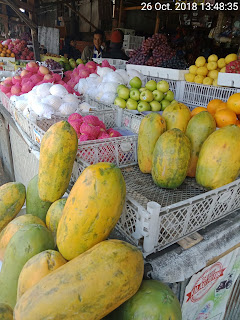Hello Semuanya, Selamat datang kembali di blog saya, postingan saya kali ini akan bercerita tentang kegiatan rutin Saya di hari jumat sore yaitu mengunjungi pasar lokal di makassar. Pasar lokal yang saya kunjungi sore ini yaitu pasar panampu. Yang terletak di Jl. Ir. juanda I.
Jarak antara Pasar panampu dengan tempat tinggal saya cukup jauh. Saya kepasar sekitar jam 14.00 pm, matahari masih panas dan jalanan juga sedikit macet.
Saya kepasar bersama teman saya. Kami survei beberapa harga bahan-bahan makanan, selain itu kami juga membeli singkong untuk membuat tapai singkong di kampus.
Langsung saja saya akan membagikan beberapa harga bahan makanan yang sudah kami survei di pasar panampu :
|
No.
|
Foodstuff
|
Price
|
|
1
|
Lemongrass
|
Rp.
5.000/Ikat
|
|
2
|
Baby
Cabbage
|
Rp.
7.000/kg
|
|
3
|
Ginger
|
Rp.
10.000/kg
|
|
4
|
Green
bean
|
Rp.
7.000/kg
|
|
5
|
Pak-Choi
|
Rp.
2.000/kg
|
|
6
|
Dried
Salted Fish
|
Rp.
55.000/kg
|
|
7
|
Sweet
Potato
|
Rp.
5.000/kg
|
|
8
|
Garlic
|
Rp.
25.000/kg
|
|
9
|
Black
Glutinous Rice
|
Rp.
27.000/kg
|
|
10
|
Duck
Egg
|
Rp.
2.500/pcs
|
|
11
|
Chicken
Egg
|
Rp.
2.500/pcs
|
|
12
|
Ordinary
Egg
|
Rp.
1.500/pcs
|
|
13
|
Peanut
|
Rp.
27.000/kg
|
|
14
|
Brown
Rice
|
Rp.
10.000/kg
|
|
15
|
Tomato
|
Rp.
7.000/kg
|
|
16
|
Potato
|
Rp.
16.000/kg
|
|
17
|
Palm
Sugar
|
Rp.
7.000/pcs
|
|
18
|
Lime
|
Rp.
30.000/kg
|
|
19
|
Shallot
|
Rp.
15.000/kg
|
|
20
|
Cucumber
|
Rp.
1.000/pcs
|
|
21
|
Gambas
|
Rp.
1.000/pcs
|
|
22
|
Soybean
Curd
|
Rp.
5.000/6pcs
|
|
23
|
Soybean
Cake
|
Rp.
5.000/pcs
|
|
24
|
Water
Rose Apple
|
Rp.
5.000/kg
|
|
25
|
Mango
|
Rp.
5.000/2pcs
|
|
26
|
Sunkist
|
Rp.
6.000/pcs
|
|
27
|
Kerupuk
Ubi
|
Rp.
5.000/2ikat
|























